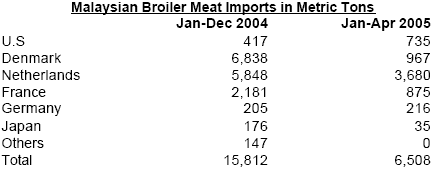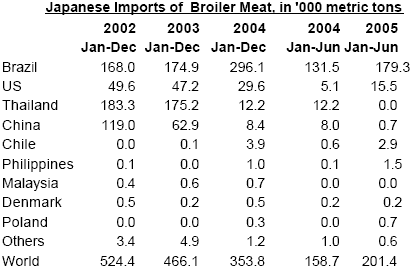



International Egg and Poultry Review: Malaysia and Japan
By the USDA's Agricultural Marketing Service - This is a weekly report looking at international developments concerning the poultry industry, this week looking at Malaysia and Japan.
Malaysia: Poultry Products
Outbreaks of highly pathogenic avian influenza in early to mid 2004
constrained demand for chicken meat into domestic and export markets
at a time of increased production. During the outbreaks, the industry
claimed that chicken demand was down 50 percent. In 2004 broiler
meat exports fell to 2,554 MT compared to 5,195 MT in 2003.
Singapore imposed a temporary suspension on all Malaysian poultry
after H5N1 was discovered in Kelantan in August 2004. Singapore
allowed limited resumption in September 2004 from Malacca and
Johore. In April 2005 poultry from Selangor and Negeri Sembilan were
allowed entry. Japan still hasn’t lifted the suspension of imports.
Singapore is Malaysia’s largest export market for live poultry and poultry
products.
Broiler production has recovered in 2005 and is projected to reach 480
million MT compared to about 454 million birds in 2004. Lower feed
prices and freight charges combined with the de-pegging of the
Malaysian ringgit (to the U.S. dollar) in July lowered the cost of production.
However, the cost of production is likely to increase due to increased
delivered prices of day old chicks and feed delivery costs due to higher
gasoline prices. In 2006, growth is likely to slow in line with a slower
pace of economic growth and rising production costs.
Annual per capita consumption of chicken is 35 kg, one of the highest
in the world. Chicken does not have dietary prohibitions or religious
restrictions – such as pork and beef for the minority Hindus and pork
for the majority Muslims. Most Muslims consumers insist on Halal and
foodservice only purchases Halal.

Malaysia periodically imports some parts, mostly from Denmark and
the Netherlands. Imports from China and Thailand are banned due to
avian influenza in those countries. The U.S. has 10 poultry facilities
approved by Malaysian authorities.
All turkey meat is imported, mostly from the US. Imports were suspended
for six months in 2004 due to a case of high path avian influenza
in Texas. The U.S. only has one turkey abattoir approved by the
Malaysian authorities.
Source: USDA/ Foreign Agricultural Service
Japan: Poultry Products
On August 1, 2005 Japan and Thailand reached a basic agreement on
a Free Trade Agreement (FTA) that will give Thailand some tariff cuts for
poultry. Actual implementation could start as soon as April 2006, which
is the beginning of Japan’s next fiscal year, and be phased in over a
period of five years.
Total imports in 2005 are projected to reach 695,000 MT (395,000
broiler meat and 300,000 prepared products). Imports for Jan-Jun
2005 jumped 53 percent to 350,892 MT compared to the same period
last year (201,429 broiler meat, 149,463 prepared products). Brazil is
the single largest supplier of frozen raw meat (mostly boneless leg
meat) with an 89 percent share. China and Thailand specialize in value
added cooked product from designated processing plants until the
ban on raw broiler meat is lifted. China has a 52 percent share of
prepared products and Thailand has a 46 percent share. Bans on raw
broiler meat from China and Thailand will probably be extended into
2006 if sporadic outbreaks continue in both countries.

Domestic broiler meat production is estimated to grow from 1,124,000 MT in 2004 to 1,130,000 MT in 2005 helped by high market prices in the first half of 2005. The 2006 broiler meat production is projected to decline slightly to 1,125,000 MT in 2006.
To view the full report, including tables please click here
Source: USDA's Agricultural Marketing Service - 13th September 2005








